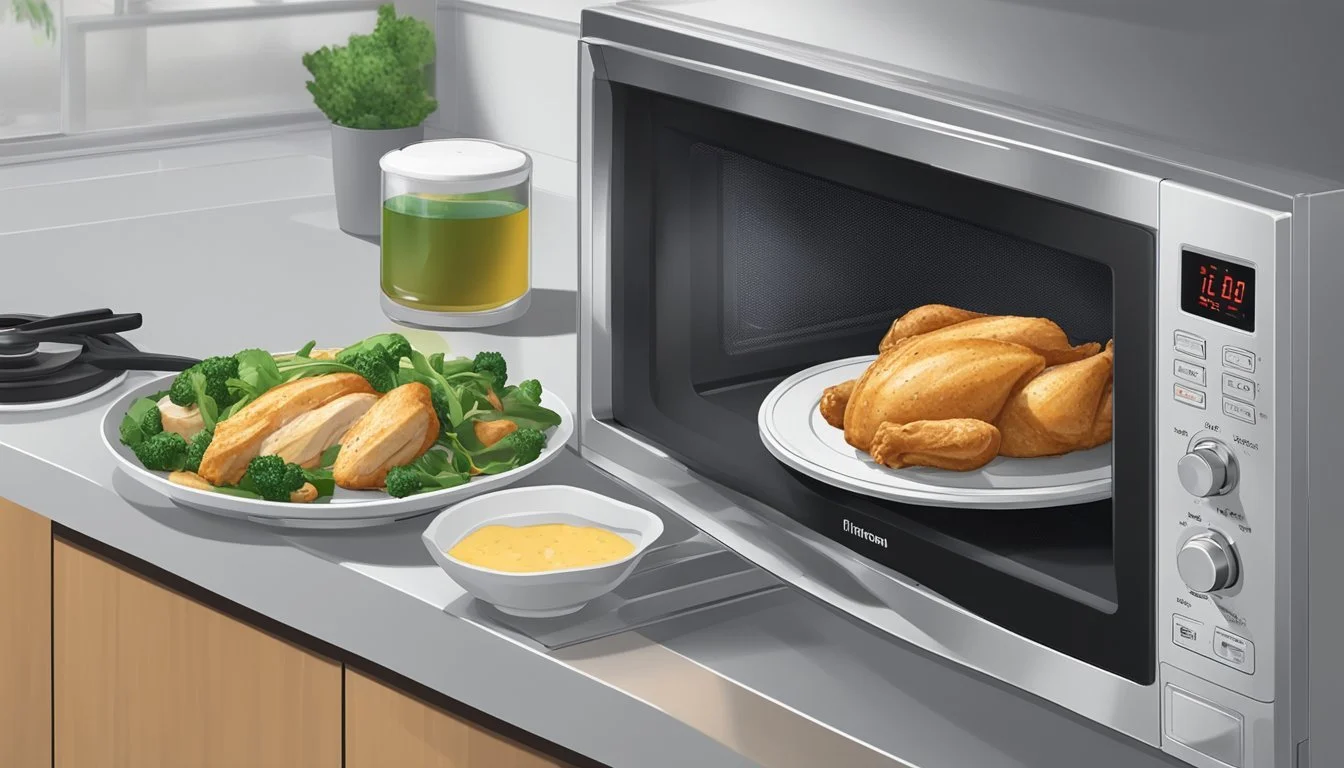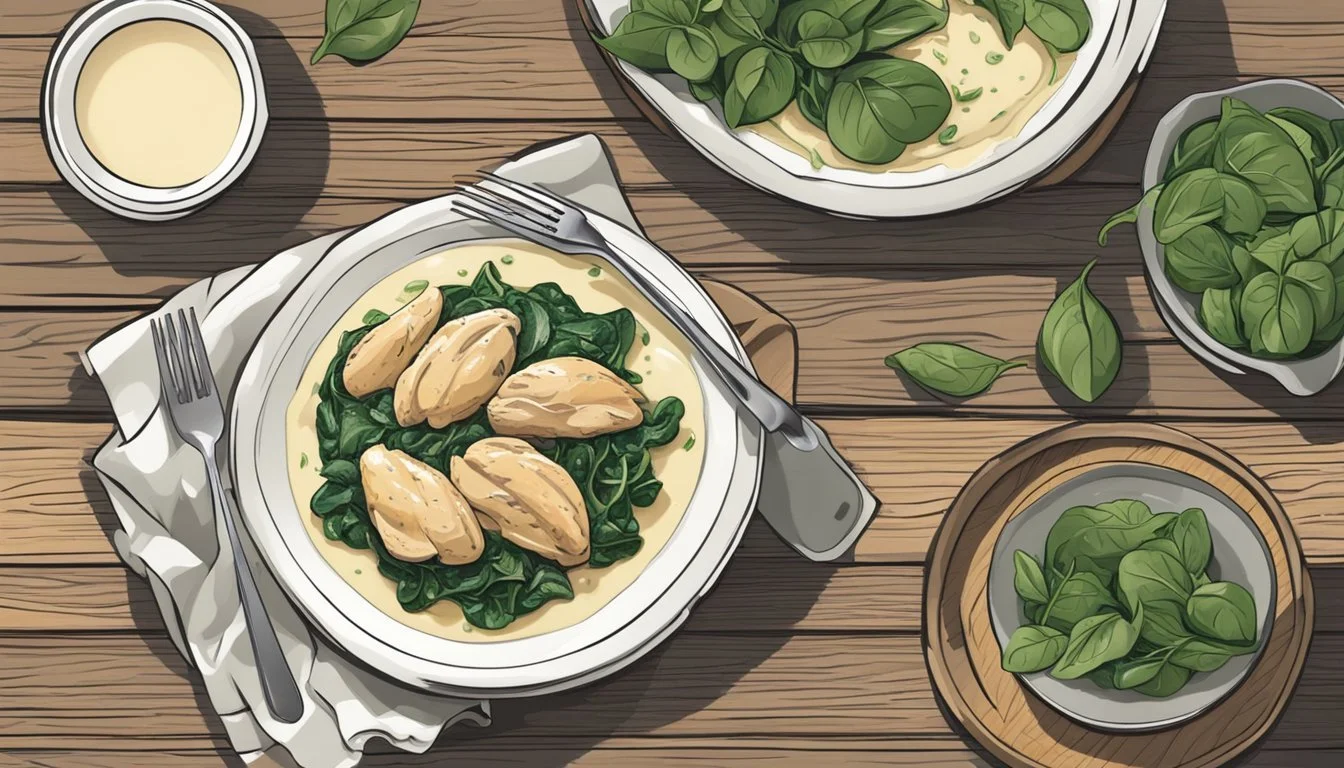How to Reheat Chicken Florentine
Expert Tips for Perfect Results
Reheating Chicken Florentine can be a straightforward and satisfying process if done correctly. The key is to keep the chicken moist and the spinach flavorful while avoiding dryness. To achieve this, avoid using a microwave as it can lead to uneven heating and dryness. Instead, opt for an oven or stovetop method.
For the oven, preheat to 350°F. Arrange the Chicken Florentine in a baking dish, ensuring there's space between pieces. Add a small amount of chicken stock to maintain moisture. Cover the dish with aluminum foil and heat for around 20 minutes until warmed through.
On the stovetop, use low heat to gently warm the Chicken Florentine. Place it in a skillet with a bit of chicken broth. Cover and occasionally stir, ensuring it heats evenly. This method helps keep the creamy sauce intact and prevents the spinach from becoming mushy.
Understanding Chicken Florentine
Chicken Florentine is a classic Italian-American dish that combines tender chicken breast, sautéed spinach, and a rich, creamy sauce. Key ingredients contribute to its distinct flavor, as well as its nutritional value.
Key Ingredients in Chicken Florentine
Chicken Florentine mainly features chicken breast, which is known for its lean protein content. This dish typically uses chicken breasts that are seasoned and cooked until golden brown.
Spinach is another crucial ingredient, providing a subtle bitterness and a wealth of nutrients. It's usually wilted in the creamy sauce, allowing it to soak up flavors.
Butter and heavy cream create the dish's signature* creamy* base. Garlic adds a layer of depth, while Parmesan cheese offers a nutty, salty profile that enriches the sauce.
Nutritional Profile
Chicken Florentine is not only flavorful but also nutritionally rich. A typical serving provides a good source of protein, thanks to the chicken breast. Spinach adds fiber, vitamin A, vitamin C, iron, and potassium.
However, the heavy cream and butter contribute fat, including saturated fat, and calories. Parmesan cheese adds calcium and some sodium.
Moderation is key when enjoying this dish, particularly for those concerned with cholesterol or sodium intake.
Preparation Tips Before Reheating
Proper preparation before reheating Chicken Florentine ensures that the dish retains its flavor and texture. Key considerations include proper storage techniques and the timing of bringing the chicken to room temperature.
Proper Storage Techniques
To keep Chicken Florentine fresh, store it in an airtight container in the fridge. This prevents moisture loss and flavor degradation. Refrigerate leftovers within two hours of cooking to minimize bacterial growth.
For longer storage, freezing is an option. Portion the chicken and sauce separately in airtight containers or freezer bags. Label them with dates to track how long they've been stored. Defrost frozen chicken in the fridge overnight for even thawing, which keeps texture and moisture intact.
When to Bring Chicken to Room Temperature
Before reheating, bring the Chicken Florentine to room temperature. This ensures even heating and reduces the time needed to reach the safe internal temperature of 165°F.
Remove the chicken from the fridge about 30 minutes before you plan to reheat it. This step is especially important when using methods like oven reheating, where sudden temperature changes can cause the chicken to dry out. Avoid leaving it out for too long to prevent bacterial growth.
Reheating Methods Overview
Reheating Chicken Florentine can be done successfully using several methods. This depends on the tools available to you and personal preference for texture and convenience.
Using the Oven
The oven method is ideal for retaining the moisture and flavor of Chicken Florentine. Preheat the oven to 350°F (175°C). Place the Chicken Florentine in a baking dish and cover it with aluminum foil to keep the moisture in. Heat for about 20-30 minutes or until the internal temperature reaches 165°F (74°C).
Checking the temperature with a meat thermometer ensures it is suitably reheated. This method requires more time but often yields the best results in terms of taste and texture.
Microwave Technique
Reheating in the microwave is the quickest method, but care must be taken to keep the chicken from drying out. Place the Chicken Florentine in a microwave-safe dish and add a tablespoon of water or broth for moisture. Cover the dish with a microwave-safe lid or plastic wrap.
Heat on medium power for 2-3 minutes, then check if it has reached 165°F (74°C). Stir or turn the chicken if needed and continue reheating at 1-minute intervals until fully heated.
Skillet Method
Using a skillet can offer quicker heating than an oven and often better texture than a microwave. Heat a skillet over medium heat and add a small amount of oil or butter. Place the Chicken Florentine in the skillet and cover with a lid.
Reheat for about 5-8 minutes, stirring occasionally, until the temperature reaches 165°F (74°C). This method is effective for reheating without drying out, especially if you prefer a crispier texture.
Alternative Reheating Options
For those with an air fryer or sous vide setup, these alternatives work well. Preheat the air fryer to 350°F (175°C) and place the chicken in the basket. Reheat for 3-4 minutes, turn it, and heat for another 3-4 minutes. Check for the 165°F (74°C) temperature.
Sous vide involves sealing the Chicken Florentine in a vacuum bag and immersing it in a water bath at 145°F (63°C) for 30-45 minutes. This method retains flavor and moisture very effectively.
Achieving the Ideal Texture and Flavor
Reheating Chicken Florentine while preserving its original qualities can be achieved by carefully considering the juiciness of the chicken, the creaminess of the sauce, and the freshness of incorporated vegetables.
Maintaining Juiciness of Chicken
To keep the chicken moist, start by reheating it slowly. Place the leftover chicken in a skillet over medium-low heat. Add a small amount of broth or olive oil to prevent it from drying out.
Covering the skillet can help retain moisture as well. It's essential not to overcook, so use a meat thermometer to ensure it reaches an internal temperature of 165°F without exceeding it. Black pepper and optional seasoning can be added for extra flavor.
Retaining Creaminess of the Sauce
For the sauce, it's crucial to reheat gently to maintain its creamy texture. Begin by heating it in a saucepan over low to medium heat. Stir frequently to avoid separation.
If the sauce thickened too much while stored, add a bit of cream or warm broth to loosen it. This will bring back the original consistency and enhance the flavor. Grating a bit of Parmesan cheese into the sauce while reheating can also enrich its taste and texture.
Adding Freshness with Greens and Vegetables
Vegetables like baby spinach and sun-dried tomatoes need to be reheated delicately or added freshly to maintain their vibrancy. For spinach, adding it in the last minute of heating ensures it stays tender but doesn’t overcook.
For a burst of fresh flavor, consider tossing in some halved cherry tomatoes just before serving. They add a delightful pop of color and freshness. Reheat these greens and vegetables gently in a bit of olive oil to preserve their natural flavors and nutrients.
Final Tips and Tricks
To ensure your reheated Chicken Florentine tastes as good as freshly made, focus on adjusting the seasoning and optimizing remaining leftovers.
Adjusting Seasoning and Garnishes
When reheating, taste the dish and adjust the seasoning as needed. Salt and pepper may need to be added to enhance the flavors that might have diminished.
Sprinkle Italian seasoning and minced garlic before serving for a fresh burst of flavor. Freshly chopped basil can add a fragrant note, while a dash of crushed red pepper gives a hint of heat.
For an added pop, sprinkle capers on top, providing a tangy contrast to the rich sauce.
Optimizing Remaining Leftovers
To maintain texture and flavor, reheat Chicken Florentine gently in a skillet over medium heat, stirring frequently. If the sauce has thickened too much, add a splash of chicken broth or cream to adjust the consistency.
After reheating, garnish with fresh spinach to restore brightness and nutrition. For a complete meal, serve alongside freshly cooked pasta or a warm crusty bread.
Avoid the microwave; it can dry out the chicken and make the sauce separate. Instead, reheating on the stove allows more control over the texture and flavor.




